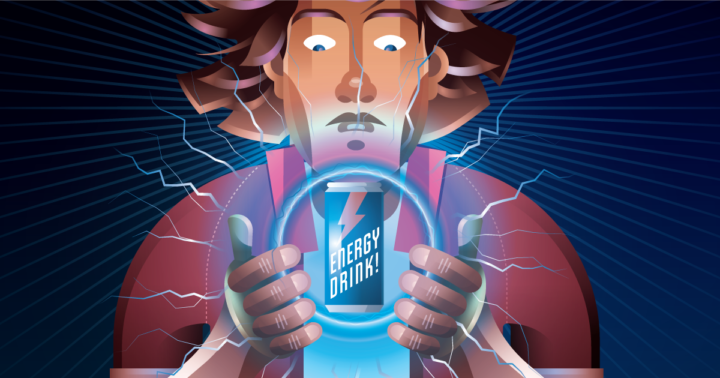The energy drinks industry is hugely lucrative, with analysts forecasting that global sales of energy and sports drinks will reach $225 billion by 2026. There are a variety of products from sugar free energy drinks to healthy energy drinks.
But why is the sector booming? We wanted to learn more about why energy drinks were so popular, which energy drinks people were buying the most and what the future looks like for the industry.
The results are shown below in an infographic that displays key elements of the business of energy drinks.

The Energy Drink Boom
The United States is one of the leading markets for energy drinks, with sales reaching $14 billion in 2021 – a $3bn increase from the 2017 figures.
Red Bull was the leading energy drink brand in the US, generating more than $3.2bn in sales. Monster Energy was close behind, with the two firms accounting for almost half of the market.
While energy drink sales have boomed, energy shots have decreased in popularity, with sales dropping from $978 million in 2020 to $824m last year.
With the consumption of energy shots tending to be an impulsive decision, pandemic shutdowns of convenience stores and fitness facilities undoubtedly impacted revenues.
However, with the world returning to some sense of normality in 2022, sales of energy shots may recover to contribute more to the ongoing energy drink boom.
Energy Drinks & eSports
The eSports industry has undoubtedly played a significant role in raising the profile of the energy drinks sector.
Several of the biggest eSports teams have secured lucrative sponsorships from energy drinks companies that have recognised the potential in this growing sector.
TSM’s $410m deal with G FUEL is top of the pile, while Cloud9 have raked in a cool $350m from their link-up with Red Bull.
Energy drinks firms aggressively market their products to gamers and eSports players based on their performance-enhancing properties.
The caffeine they contain boosts cognition, improves reaction times and helps to resist fatigue, allowing players to maintain peak gaming performance.
What’s the Difference Between Pre-Workout Supplements & Energy Drinks?
Sales of pre-workout supplements have been forecast to reach $12.6 billion by 2027, but how do they differ from energy drinks?
Ultimately it boils down to their goal. Pre-workout supplements are designed to boost your energy levels and promote better athletic performance.
By contrast, energy drinks provide a rapid energy boost by supplying users with a moderate dose of caffeine and other fast-acting supplements.
In simple terms, both increase your energy levels, but pre-workout supplements are also designed to improve athletic performance and endurance.
However, the lines between pre-workout supplements and energy drinks have become increasingly blurred as many of the latter products claim to do a similar job.
What are the Key Pre-Workout & Energy Drink Ingredients?
Pre-workout supplements contain a combination of energy and performance-boosting ingredients.
Some blends are similar to the ingredients in energy drinks. Here is a comprehensive list of pre-workout ingredients:
- Energy Ingredients: Caffeine, Vitamin B3, Vitamin B6, Vitamin B12, L-Carnitine, Theobromine, Yohimbe.
- Pump Ingredients: L-Citrulline, Beet Root Extract, Red Spinach Extract, Nitrosigine, Agmatine, L-Arginine, ElevATP.
- Strength Ingredients: Betaine Anhydrous, Creatine Monohydrate, D-Aspartic Acid, EAAs, BCAAs.
- Endurance Ingredients: Beta-Alanine, L-Ornithine HCL, Taurine.
- Focus Ingredients: L-Tyrosine, Alpha GPC, Choline Bitartrate, L-Theanine.
- Mood-Boosting Ingredients: Rhodiola Rosea.
- Electrolyte Ingredients: Sodium, Potassium, Magnesium, Calcium, Phosphate, Chloride, Coconut Water Powder.
More than half of the top 100 pre-workout drinks include a proprietary blend of ingredients that aren’t specified on the label.
Who Buys Energy Drinks?
People in North America consume more energy drinks than in any other region.
Around two in three energy drink consumers are aged between 13 and 35, while the same percentage are male.
They are attracted to the products due to claims of improved performance, alertness, endurance and increased awareness of an active lifestyle.
While North America is a lucrative market for energy drinks, it is worth noting that less than half of US consumers use such products.
Non-users claim energy drinks are too sugary, don’t taste natural and fail to provide the benefits they advertise.
What is the Future Of Energy Drinks?
As with any thriving sector, the energy drinks industry will continue to evolve as it strives to appeal to even more consumers.
Increased use of plant-based energy ingredients along with reformulations including more natural sources of caffeine are amongst the changes we are likely to see.
There will also be a focus on better quality ingredients as energy drinks companies work towards converting sceptics to their products.
New technology will allow for improved manufacturing processes, particularly with regard to reducing the sugars naturally found in fruit juices.
This will feed into the shift towards energy drinks firms focusing on delivering sustainable energy benefits derived from more natural products than sugar and caffeine.
The Business Of Energy Drinks: Survey Methodology
We compiled data from several respected sources to take an in-depth look at the business of energy drinks.
These included Grand View Research, National Library of Medicine, Medical News Today, Beverage Industry and many more.
Related Posts:
- Sports Injuries: Causes, Types, Treatment & Prevention
- 50 Interesting Facts About Pre-Workout
- Is Coffee The Only Pre-Workout You Need?
- 50 Pre-Workout Stats
- Great Hotel Room Workouts You Can Do Wherever You Travel
